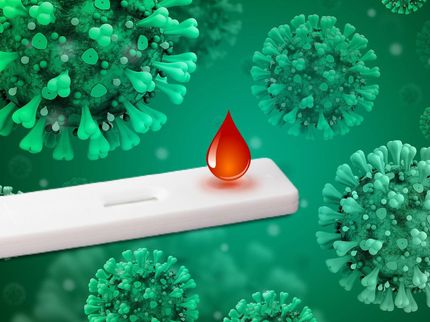Synthetic Genes for Flu Test
Electrochemical biosensor for antibody detection
The quantitative detection of specific antibodies in complex samples such as blood can inform on many different diseases but usually requires a complicated laboratory procedure. A new method for the rapid, inexpensive, yet quantitative and specific point-of-care detection of antibodies has now been introduced in the journal Angewandte Chemie by an Italian research team. It uses an electrochemical cell-free biosensor that can directly detect antibodies against diseases such as influenza in blood serum.

© Wiley-VCH
Influenza is a severe, widespread, epidemic disease that can be fatal and may also have significant societal and economic consequences. The clinical evaluation of immune responses to flu vaccines and infections is thus correspondingly important. A simple, inexpensive, point-of-care diagnostic method would be preferable to current expensive and complex laboratory analysis.
A new method developed by Sara Bracaglia, Simona Ranallo, and Francesco Ricci (University of Rome) fulfills this wish. It is based on “programmable” gene circuits, cell-free transcription, and electrochemical detection.
In living cells, genes are read by RNA polymerases and transcribed into an RNA sequence, which then serves as a blueprint for building proteins (translation). This “machinery” can also be used by cell-free systems. To build their new detector, the team combined this type of machinery with specifically designed synthetic gene circuits that only get “switched on” when the antibody being tested for is present in the sample. As an example, they designed a test that detects anti-influenza antibodies, which are directed against a surface molecule on influenza viruses.
To do this, the team developed a synthetic gene with an incomplete promoter. The promoter is a DNA segment that controls the reading of the gene. If the promoter is incomplete RNA polymerase cannot start the transcription of RNA. The test solution also contains a pair of synthetic DNA strands that are bound to a protein portion (also called peptide) that is specifically recognized by anti-influenza antibodies. Upon binding between the antibodies and the peptide, the two DNA strands are arranged in a way that completes the promoter and switches the synthetic gene on. The RNA polymerase can now dock on the synthetic gene and start transcribing RNA strands. These RNA strands in turn can bind specifically to a DNA probe fixed to a small disposable electrode and give a measurable current signal change. As long as no antibodies are present, no RNA will be transcribed and no change in current signal will be measured by the disposable electrode. If the sample contains influenza antibodies, the machinery synthesizes RNA, which binds to the electrode leading to a current signal.
The system requires only very small sample volumes, is very specific and sensitive, reliable, and inexpensive. Thus, it can be readily miniaturized to make a portable and easy-to-use diagnostic tool. It is also adaptable for the detection of a wide variety of other antibodies.
Original publication
These products might interest you

Octet R2 / Octet R4 / Octet R8 by Sartorius
Full power on 2, 4 or 8 channels: Label-free and GxP-compliant analysis of molecular interactions
Innovative label-free real-time protein quantification, binding kinetics and rapid screenings

Octet RH16 and RH96 by Sartorius
Efficient protein analysis for process optimisation and manufacturing control in high-throughput
Label-free protein quantification and characterization of protein-protein interactions

Octet SF3 by Sartorius
Surface Plasmon Resonance (SPR) using Single Dynamic Injections for Kinetics and Affinities
Curvature is Key - Adding a ‘Third Dimension’ to the Binding Curve

Get the analytics and lab tech industry in your inbox
By submitting this form you agree that LUMITOS AG will send you the newsletter(s) selected above by email. Your data will not be passed on to third parties. Your data will be stored and processed in accordance with our data protection regulations. LUMITOS may contact you by email for the purpose of advertising or market and opinion surveys. You can revoke your consent at any time without giving reasons to LUMITOS AG, Ernst-Augustin-Str. 2, 12489 Berlin, Germany or by e-mail at revoke@lumitos.com with effect for the future. In addition, each email contains a link to unsubscribe from the corresponding newsletter.
More news from our other portals
See the theme worlds for related content
Topic world Antibodies
Antibodies are specialized molecules of our immune system that can specifically recognize and neutralize pathogens or foreign substances. Antibody research in biotech and pharma has recognized this natural defense potential and is working intensively to make it therapeutically useful. From monoclonal antibodies used against cancer or autoimmune diseases to antibody-drug conjugates that specifically transport drugs to disease cells - the possibilities are enormous

Topic world Antibodies
Antibodies are specialized molecules of our immune system that can specifically recognize and neutralize pathogens or foreign substances. Antibody research in biotech and pharma has recognized this natural defense potential and is working intensively to make it therapeutically useful. From monoclonal antibodies used against cancer or autoimmune diseases to antibody-drug conjugates that specifically transport drugs to disease cells - the possibilities are enormous
Topic world Diagnostics
Diagnostics is at the heart of modern medicine and forms a crucial interface between research and patient care in the biotech and pharmaceutical industries. It not only enables early detection and monitoring of disease, but also plays a central role in individualized medicine by enabling targeted therapies based on an individual's genetic and molecular signature.

Topic world Diagnostics
Diagnostics is at the heart of modern medicine and forms a crucial interface between research and patient care in the biotech and pharmaceutical industries. It not only enables early detection and monitoring of disease, but also plays a central role in individualized medicine by enabling targeted therapies based on an individual's genetic and molecular signature.























































